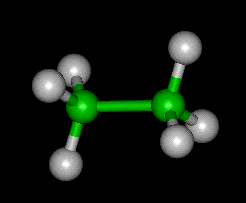Ethane Molecule

To View the Ethqne Molecule in 3D --->>in 3D with Jsmol
Chemical and Physical Properties of Ethane
Ethane is a chemical compound with chemical formula C2H6, structural formula CH3-CH3.
It is an alkane, that is, an aliphatic hydrocarbon. At ordinary pressure and temperature ethane is a colourless, odourless gas; boiling point is ?88.6°; melting point is ?183.3°.
It is the simplest hydrocarbon containing more than one carbon atom. Ethane is a prominent compound of industrial importance, by converting it to ethylene or using it as a building block for the petrochemical industry, for the synthesis both of polyethylene plastic and other small compounds.
Ethane was first synthetically created in 1834 by Michael Faraday, applying electrolysis of a potassium acetate solution. He mistook the hydrocarbon product of this reaction for methane, and did not investigate it further. During the period 1847–1849, in an effort to vindicate the radical theory of organic chemistry, Hermann Kolbe and Edward Frankland produced ethane by the reductions of propionitrile (ethyl cyanide) and ethyl iodide with potassium metal, and, as did Faraday, by the electrolysis of aqueous acetates. They, however, mistook the product of these reactions for methyl radical, rather than the dimer of methyl, ethane. This error was corrected in 1864 by Carl Schorlemmer, who showed that the product of all these reactions was in fact ethane.
The chief use of ethane is in the chemical industry in the production of ethene (ethylene) by steam cracking. When diluted with steam and briefly heated to very high temperatures (900 °C or more), heavy hydrocarbons break down into lighter hydrocarbons, and saturated hydrocarbons become unsaturated. Ethane is favored for ethene production because the steam cracking of ethane is fairly selective for ethene, while the steam cracking of heavier hydrocarbons yields a product mixture poorer in ethene, and richer in heavier alkenes (olefins) such as propene (propylene) and butadiene, and in aromatic hydrocarbons.
Ethane occurs as a trace gas in the Earth's atmosphere, currently having a concentration at sea level of 0.5 ppbv,[8] though its pre-Industrial concentration is likely to have been lower since a significant proportion of the ethane in today's atmosphere may have originated as fossil fuels. Although ethane is a greenhouse gas, it is much less abundant than methane and also less efficient relative to mass. It has also been detected as a trace component in the atmospheres of all four giant planets, and in the atmosphere of Saturn's moon Titan.
See also:
What is the geometry of the methane molecule? An interactive activity which includes the jsmol applet of methane.